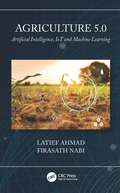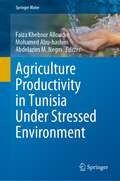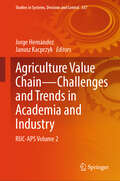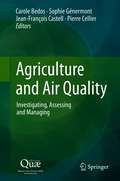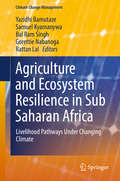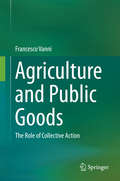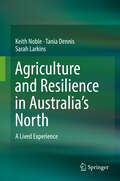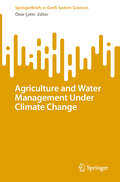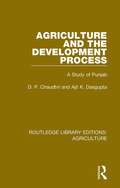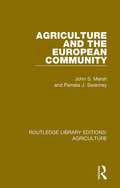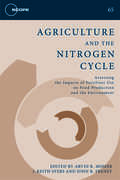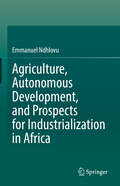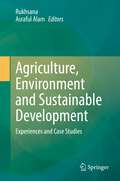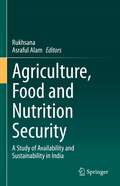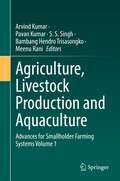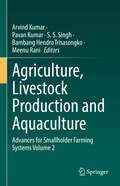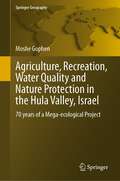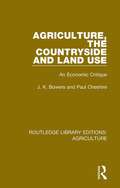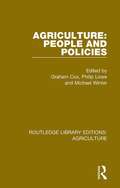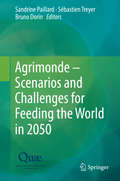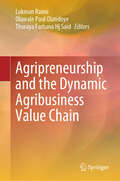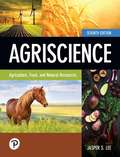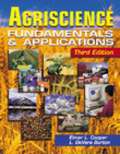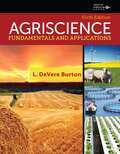- Table View
- List View
Agriculture 5.0: Artificial Intelligence, IoT and Machine Learning
by Latief Ahmad Firasath NabiAgriculture 5.0: Artificial Intelligence, IoT & Machine Learning provides an interdisciplinary, integrative overview of latest development in the domain of smart farming. It shows how the traditional farming practices are being enhanced and modified by automation and introduction of modern scalable technological solutions that cut down on risks, enhance sustainability, and deliver predictive decisions to the grower, in order to make agriculture more productive. An elaborative approach has been used to highlight the applicability and adoption of key technologies and techniques such WSN, IoT, AI and ML in agronomic activities ranging from collection of information, analysing and drawing meaningful insights from the information which is more accurate, timely and reliable.It synthesizes interdisciplinary theory, concepts, definitions, models and findings involved in complex global sustainability problem-solving, making it an essential guide and reference. It includes real-world examples and applications making the book accessible to a broader interdisciplinary readership. This book clarifies hoe the birth of smart and intelligent agriculture is being nurtured and driven by the deployment of tiny sensors or AI/ML enabled UAV’s or low powered Internet of Things setups for the sensing, monitoring, collection, processing and storing of the information over the cloud platforms. This book is ideal for researchers, academics, post-graduate students and practitioners of agricultural universities, who want to embrace new agricultural technologies for Determination of site-specific crop requirements, future farming strategies related to controlling of chemical sprays, yield, price assessments with the help of AI/ML driven intelligent decision support systems and use of agri-robots for sowing and harvesting. The book will be covering and exploring the applications and some case studies of each technology, that have heavily made impact as grand successes. The main aim of the book is to give the readers immense insights into the impact and scope of WSN, IoT, AI and ML in the growth of intelligent digital farming and Agriculture revolution 5.0.The book also focuses on feasibility of precision farming and the problems faced during adoption of precision farming techniques, its potential in India and various policy measures taken all over the world. The reader can find a description of different decision support tools like crop simulation models, their types, and application in PA. Features: Detailed description of the latest tools and technologies available for the Agriculture 5.0. Elaborative information for different type of hardware, platforms and machine learning techniques for use in smart farming. Elucidates various types of predictive modeling techniques available for intelligent and accurate agricultural decision making from real time collected information for site specific precision farming. Information about different type of regulations and policies made by all over the world for the motivation farmers and innovators to invest and adopt the AI and ML enabled tools and farming systems for sustainable production.
Agriculture Productivity in Tunisia Under Stressed Environment (Springer Water)
by Abdelazim M. Negm Mohamed Abu-Hashim Faiza Khebour AlloucheThis book highlights recent efforts to sustain agricultural productivity in Tunisia under a stressed environment and aridity conditions. This book's authors gathered a unique set of applications and approaches, including techniques applied to increase yield and preserve the environment, such as organic farming and using biochar amendment and its effects on soils' physicochemical properties. This book also presents water resources management and water management practices for sustainable soil production, diagnosis, and new farming technologies to enhance water-use efficiency. The book also addresses current livestock strategies intended to maintain production sustainability, increase fish productivity, and initiatives for sustainable tourism development.Given its scope, the book offers a valuable guide for policy planners, decision-makers, stakeholders, researchers, and graduate students in Tunisia and neighboring countries with similarly stressed environmental conditions.
Agriculture Value Chain — Challenges and Trends in Academia and Industry: RUC-APS Volume 2 (Studies in Systems, Decision and Control #557)
by Janusz Kacprzyk Jorge HernándezThis book stands as a significant milestone in the realm of agricultural research and innovation, representing the comprehensive efforts of the RUC-APS Project. The RUC-APS Project, officially known as "Enhancing and Implementing Knowledge-Based ICT Solutions Within High-Risk and Uncertain Conditions for Agriculture Production Systems," was a collaborative initiative under the H2020 European Framework, running from October 3, 2016, to April 2, 2022. Spearheaded by the esteemed Prof. Jorge Hernández, formerly of the University of Liverpool, UK, and currently affiliated with Universidad Adolfo Ibañez, Santiago de Chile, the project brought together a consortium of 16 participants from 5 EU countries and 3 partners from 2 third countries. This book marks the culmination of rigorous research and insights garnered through a meticulous peer-review process involving contributions from various RUC-APS international conferences held between 2021 and 2023. It delves into the pressing need to address the challenges faced by modern agricultural systems, particularly agricultural value chains, amidst volatile and uncertain environmental conditions. The ever-changing landscape of resources, coupled with factors like unpredictable weather patterns, pest infestations, market fluctuations, and fluctuating commodity prices, necessitates a holistic and adaptive approach to ensure resilience and sustainability across the agricultural value chain. Navigating these complexities requires informed decision-making processes that account for risks throughout the entire agricultural lifecycle. The complexity of these decision-making paradigms underscores the critical importance of this book and the insights gleaned from the RUC-APS Project. By shedding light on multifaceted challenges and proposing innovative solutions, this collaborative effort aims to pave the way for a more resilient and sustainable agricultural landscape.
Agriculture and Air Quality: Investigating, Assessing and Managing
by Carole Bedos Sophie Génermont Jean-François Castell Pierre CellierThis book gives an overview of the relationships between agriculture and air quality, which is an issue of increasing importance for practitioners and policy makers. It provides the keys to understand natural and anthropogenic mechanisms governing emission and deposition of pollutants produced by and/or impacting agricultural activitiesIt identifies how management practices can help mitigating emissions and how public policies on air pollution progressively addressed the agricultural sectorThis book was written for students, researchers and agriculture actors as well as for public decision-makers
Agriculture and Ecosystem Resilience in Sub Saharan Africa: Livelihood Pathways Under Changing Climate (Climate Change Management)
by Rattan Lal Bal Ram Singh Yazidhi Bamutaze Samuel Kyamanywa Gorettie NabanogaThis volume discusses emerging contexts of agricultural and ecosystem resilience in Sub Saharan Africa, as well as contemporary technological advances that have influenced African livelihoods. In six sections, the book addresses the sustainable development goals to mitigate the negative impacts on agricultural productivity brought about by climate change in Africa. Some of the challenges assessed include soil degradation, land use changes, natural resource mismanagement, declining crop productivity, and economic stagnation. This book will be of interest to researchers, NGOs, and development organizations.Section 1 focuses on climate risk management in tropical Africa. Section 2 addresses the water-ecosystem-agriculture nexus, and identifies the best strategies for sustainable water use. Section 3 introduces Information Communication Technology (ICT), and how it can be used for ecosystem and human resilience to improve quality of life in communities. Section 4 discusses the science and policies of transformative agriculture, including challenges facing crop production and management. Section 5 addresses landscape processes, human security, and governance of agro-ecosystems. Section 6 concludes the book with chapters uniquely covering the gender dynamics of agricultural, ecosystem, and livelihood resilience.
Agriculture and Public Goods: The Role of Collective Action
by Francesco VanniThe debate on the future orientation of the EU Common Agricultural Policy (CAP) is increasingly shaped by the role of agriculture in providing public goods, and there is a broad consensus that this approach will be particularly relevant in legitimating the policy intervention in agriculture in the future. In the context of this debate, it is not clear to what extent collective action could be taken into consideration as a valuable alternative to market or state regulation in contributing to the provision of public goods, and to what extent it is possible to design and implement agricultural policies that incorporate a collective and collaborative approach between different stakeholders in rural areas. Through an in depth analysis two case studies in Italy, the book provides insights to both the policy and the theoretical debate on the role of collective action for the public goods associated to agriculture.
Agriculture and Resilience in Australia’s North: A Lived Experience
by Keith Noble Tania Dennis Sarah LarkinsThis book examines the mechanisms and strategies farmers in North Australia adopt to manage the setbacks and challenges they face. This social research is based on farmers’ experiences, but also draws on the author’s own experience after his tropical fruit farm was destroyed by two Category 5 cyclones in five years.Through historical analysis, the book compares historic and contemporary aspirations for northern development, and discusses the influence of the built environment on individuals as well as access to health and other social services.Exploring the implications of individual resilience strategies for policy development within the broader context of northern development and evolving environmental governance, the book also highlights the fact that this is occurring in a new geological epoch – the Anthropocene.The book will provide a unique perspective and understanding to government, individuals and industries interested in northern Australia and its relationship to the world
Agriculture and Water Management Under Climate Change (SpringerBriefs in Earth System Sciences)
by Öner ÇetinThis book analyzes how major events such as the recent pandemic crisis, wars around the world and climate change, have affected agricultural production and the direct food supply. In this sense, human nutrition will never be off the agenda. The book provides information and guidelines for both practitioners and decision-makers about important developments in the use of agriculture, soil and water resources for agricultural purposes, including the effective and efficient use of soil and water resources where agricultural production, increasing water productivity, the use of modern technology and digitalization for this purpose. Accordingly, a number of chapters have been prepared by experts in the field, covering a variety of the above-mentioned objectives.
Agriculture and the Development Process: A Study of Punjab (Routledge Library Editions: Agriculture #2)
by Ajit K. Dasgupta D. P. ChaudhriFirst published in 1985. The need to increase agricultural output and to use increased output to generate sustained general economic development is a problem facing many Third World countries. This book explores in particular the agricultural growth of the Punjab in Northern India, a country which has long been a leader in the formulation of new development strategies. It shows how agricultural output is affected by, and affects, demographic changes, income distribution, state involvement and structural changes both in society and the economy. Agricultural growth in the Punjab is seen in an historical perspective. In addition, the different aspects of economic development are viewed in an integrated way so that much is learned about the contribution of agricultural growth to the development process. The conclusions drawn can be related to problems and trends worldwide.
Agriculture and the European Community (Routledge Library Editions: Agriculture #3)
by John S. Marsh Pamela J. SwanneyFirst published in 1980. From the earliest beginnings of the European Economic Community, it was recognised that a common market for agriculture would be one of the basic prerequisites for workable economic unity. And yet the Common Agricultural Policy (CAP) remained a subject of much controversy and debate. The CAP, more than any other element of European policy, was seen to test the true depth of the commitment shown by Community members to the practice as well as the principle of economic integration. Agriculture and the European Community examines the reasons for the existence of the CAP and its format. It outlines the main instruments, price and structural policy, and the changing emphasis between them. It discusses in turn the effects of the CAP on producers’ income levels and on consumer prices; how far it had fulfilled the promises of the Treaty of Rome; the implications of the policy for third country trade; and its place within the Community as a whole. The study argues that, although incomes of Community farmers had improved, this is not simply the result of the CAP, nor was the geographical distribution of benefit in terms of farming income satisfactory. The policy has achieved a degree of success in securing food supplies and stabilising prices but the cost to the consumer has been high. Knowledge of the CAP had become almost essential to any understanding of modern European affairs. Agriculture and the European Community will serve as a straightforward introduction to the policy for students approaching the subject for the first time, especially in departments of Agricultural Economics, European Studies and Political Science.
Agriculture and the Nitrogen Cycle: Assessing the Impacts of Fertilizer Use on Food Production and the Environment (SCOPE Series #65)
by John R. Freney Arvin Mosier J. Keith SyersNitrogen is an essential element for plant growth and development and a key agricultural input-but in excess it can lead to a host of problems for human and ecological health. Across the globe, distribution of fertilizer nitrogen is very uneven, with some areas subject to nitrogen pollution and others suffering from reduced soil fertility, diminished crop production, and other consequences of inadequate supply. Agriculture and the Nitrogen Cycle provides a global assessment of the role of nitrogen fertilizer in the nitrogen cycle. The focus of the book is regional, emphasizing the need to maintain food and fiber production while minimizing environmental impacts where fertilizer is abundant, and the need to enhance fertilizer utilization in systems where nitrogen is limited. The book is derived from a workshop held by the Scientific Committee on Problems of the Environment (SCOPE) in Kampala, Uganda, that brought together the world's leading scientists to examine and discuss the nitrogen cycle and related problems. It contains an overview chapter that summarizes the group's findings, four chapters on cross-cutting issues, and thirteen background chapters. The book offers a unique synthesis and provides an up-to-date, broad perspective on the issues of nitrogen fertilizer in food production and the interaction of nitrogen and the environment.
Agriculture, Autonomous Development, and Prospects for Industrialization in Africa
by Emmanuel NdhlovuThe book investigates the intersection of agriculture and development in Africa and how it impacts rural industrialisation prospects. It provides a comprehensive view of the position of agriculture in African socio-economic activities and the agricultural sector's potential as the source for continental development and industrialisation prospects. Significant research has been done on African development with a focus placed on the problematic role played by slavery, colonialism and later by incompetent African leaders who failed to steer development of the type that delivers a progressive, sustained and sustainable transformation of lives and societies. There is limited focus on the possibility of agriculture being the potential basis of African development and the chance for industrialisation. This is a matter of concern, considering the dominance of agriculture as a livelihood and income source for many people on the continent. In contributing to the debate on development in Africa, this book aims to show how agriculture can serve as the basis for African development and industrialisation. This will be achieved by (i) providing a detailed historical description of the position of agriculture in African socio-economic activities, (ii) outlining the trajectory of African development with a focus on agriculture, innovation, and mechanisation, (iii) identifying challenges to the development of African agriculture, (iv) exploring the opportunities for agricultural development in Africa, and (v) providing practical and policy recommendations to improve African agriculture and make it the engine for development and industrialisation. Utilising a multidisciplinary approach which combines political economy, social policy, financial inclusion, and empowerment approaches, the book also shows how engagement of youth and women, digitalisation, and the provision of support (by public and private actors) can jump-start agriculture as the engine of African development and industrialisation. Taken together with this conscious effort to promote a multi-disciplinary discussion, the book is valuable reading for students, policymakers, and activists interested in emerging new directions in African development thinking and research.
Agriculture, Environment and Sustainable Development: Experiences and Case Studies
by Rukhsana Asraful AlamThis volume is intended to provide a comprehensive understanding of recent innovations related to the study of agricultural and environmental management for sustainable development. The book clearly identifies why the fight to achieve sustainable development in agricultural production must be fought along a broad multidisciplinary front to overcome issues such as soil erosion, poor water quality, pesticide contamination, and food insecurity. Readers are given a broad exposition of the trends and current practices of basic principles on sustainable agriculture, along with a detailed understanding of the use of sustainable agriculture to develop environmentally sustainable food production systems. The chapters describe the ecological sustainability of agricultural systems, current innovations to improve efficiency in the use of resources for sustainable agriculture, and the proposal for technological options and new areas of research in this very significant field of agriculture. The authors aim to provide readers with a good subject understanding which will assist in the identification of agricultural development, environmental risk, sustainable resource management and design of appropriate responses. This book will be very helpful for students, researchers and practitioners interested in the fields of agriculture, environment and sustainable development.
Agriculture, Food and Nutrition Security: A Study of Availability and Sustainability in India
by Rukhsana Asraful AlamThis volume provides an interdisciplinary collection of studies that cover the trends and issues related to agricultural productivity and availability, food and nutrition security, and sustainability in India. The book discusses a broad range of vital issues concerning the production and consumption of food during the era of climate change, and has been prepared to generate awareness of these issues in a large agricultural economy to shed light on new perspectives and solutions to achieve sustainable food production and security in India. The book is organized into three major sections: Climate and Agricultural Productivity for Availability, Changes and Trends in Cropping Patterns and Food Security, and Food and Nutrition Security for Sustainable Development. The book will be of interest to students, researchers, policymakers, and other inquisitive readers interested in different aspects of agriculture, food and nutrition security, and sustainable development.
Agriculture, Livestock Production and Aquaculture: Advances for Smallholder Farming Systems Volume 1
by Arvind Kumar Pavan Kumar Meenu Rani S. S. Singh Bambang Hendro TrisasongkoThis two-volume set discusses recent approaches and technological innovations for sustainable agriculture in smallholder farming systems impacted by climate change. The systems covered include crop-based agricultural production, as well as aquaculture and livestock production as related systems using similar techniques to combat food security issues brought about by climate change and resource overuse. The chapters detail innovations involving crop diversification, soil resilience management, geoinformatics and land suitability monitoring for smart farming, information technology in livestock production, and nutrient resource management in fishery aquaculture. Researchers, practitioners and industries will be able to use this information to implement socially and economically sustainable practices to achieve food security in impoverished areas vulnerable to climate change, while also learning about the rapid evolution in information technology that is applicable for and available to small holder farmers. Volume 1 focuses on current innovations in agricultural and livestock practices in response to climate change. It covers the technological challenges, approaches and mitigation strategies encountered by both scholars and practitioners working in livestock and agricultural production systems impacted by climate change.
Agriculture, Livestock Production and Aquaculture: Advances for Smallholder Farming Systems Volume 2
by Arvind Kumar Pavan Kumar Meenu Rani S. S. Singh Bambang Hendro TrisasongkoThis two-volume set discusses recent approaches and technological innovations for sustainable agriculture in smallholder farming systems impacted by climate change. The systems covered include crop-based agricultural production, as well as aquaculture and livestock production as related systems using similar techniques to combat food security issues brought about by climate change and resource overuse. The chapters detail innovations involving crop diversification, soil resilience management, geoinformatics and land suitability monitoring for smart farming, information technology in livestock production, and nutrient resource management in fishery aquaculture. Researchers, practitioners and industries will be able to use this information to implement socially and economically sustainable practices to achieve food security in impoverished areas vulnerable to climate change, while also learning about the rapid evolution in information technology that is applicable for and available to small holder farmers. Volume 2 focuses on trends and technologies in food security within the context of sustainable practices, drone technology, microwave data, molecular farming, machine learning, agricultural economics, spatial modeling and agricultural policy. These chapters discuss advancements in fishery resource and aquaculture practices, and also the challenges facing these areas due to climate change.
Agriculture, Recreation, Water Quality and Nature Protection in the Hula Valley, Israel: 70 years of a Mega-ecological Project (Springer Geography)
by Moshe GophenThe anxious search for agricultural income resources, and assurance of the national water supply in the northern newly created state of Israel initiated the national project of the Hula Drainage. The implementation of this project was accompanied as of today by research and monitoring of the ecological trait aimed at crop harvest improvement in the Hula valley and prevention of water quality deterioration in Lake Kinneret. Forty years later a reclamation project to improve the peat soil property and renovate the hydrological system was carried out. This book documents the scientific research carried out during this mega-ecological project. Several issues of the ecological renovation and its impact on the Hula valley management and water quality in lake Kinneret are presented in this book. The advantage and contribution of a newly created shallow lake Agmon-Hula to nutrient dynamics, and hydrological control, accompanied by avian presence, (among others, Cranes, Storks, Pelicans, Flamingoes) and plants renewal which enhanced, tourism; potential impact of nitrogen and sulfate migration from the Hula valley on the Kinneret water quality; the role of climate change on the ecology of the Hula Valley and the Kinneret nutrient availabilities and phytoplankton community; the subterranean migration of water and nutrients and water loss. Further proposals for future development are under consideration. This book presents a comprehensive practical management implementation of a long-term ecological project. Results of scientific and monitoring research which followed the project implementation benefit the international and national communities.
Agriculture, the Countryside and Land Use: An Economic Critique (Routledge Library Editions: Agriculture #4)
by J. K. Bowers Paul CheshireFirst published in 1983. How had the situation developed in which agriculture had become such a creature of state protection, where public money supported prosperous landowners while poor farmers received practically nothing? Where the value of agricultural support exceeded net farm income, and vastly exceeded the level of support available to British Steel or British Rail? In answering these questions John Bowers and Paul Cheshire examined the real value of agricultural support in successive policy phases since the Second World War, and analysed the effects this support had on income distribution. Their thesis was that agricultural change, including the transfer of land from traditional farmers to institutions and corporations, was not the product of impersonal progress, but the direct result of agricultural support policies, resting on specious economic arguments. The authors’ analysis of this subject has inescapable relevance for the policymaker, for the taxpayer and consumer of foodstuffs, for the urban user of the British countryside and indeed for farmers and the farming lobby. Agriculture, the Countryside and Land Use will be an important book for all these groups and also for students of agriculture, geography and economics.
Agriculture: People and Policies (Routledge Library Editions: Agriculture #5)
by Michael Winter Philip Lowe Graham CoxThe structure and future of Britain’s agriculture sector are the central concerns of this volume, first published in 1986. It critically examines the mystique surrounding agriculture which has done much to underpin the special support the industry had enjoyed. The papers collected here address many of the key questions: What is distinctive about the social and economic organisation of agricultural production? What are the main factors which have influenced policy formation? And how are the policy makers likely to respond to widespread concern about the economic and environmental impact of those policies?
Agrimonde - Scenarios and Challenges for Feeding the World in 2050: Scenarios And Challenges For Feeding The World In 2050
by Sandrine Paillard Sébastien Treyer Bruno DorinHow will the world be able to feed close to 9 billion people in 2050 and still maintain the ecosystems? In this perspective, INRA and CIRAD launched the initiative, in 2006, to develop a foresight project for analysing issues pertaining to the world's food and agricultural systems on the 2050 timeline. This book provides a synthetic presentation of the main conclusions that this foresight project has yielded. First, it recapitulates the main statistical references for the period 1961 to 2003, before going on to describe the Agribiom simulation tool used to calculate food biomass resource use balances. Two scenarios on the 2050 timeline are then considered: Agrimonde GO is a trend-based scenario that bets on economic growth to feed the world, in a context where environmental protection is not a priority; in contrast, the idea in Agrimonde 1 is to feed the world while preserving its ecosystems.
Agripreneurship and the Dynamic Agribusiness Value Chain
by Lukman Raimi Olawale Paul Olatidoye Thuraya Farhana Hj SaidThis book provides an insightful exploration of agribusiness entrepreneurship in the dynamic landscape of the global economy. Targeted at agribusiness researchers, agricultural scientists, finance professionals, and consultants, the thematic focus encompasses agricultural and business entrepreneurship, production and consumption dynamics, ethical considerations, impact investments, and disruptive technologies such as Bitcoin, digital ventures, cryptocurrency, and blockchain. Addressing the principles governing innovative business models, the text delves into the multifaceted realm of entrepreneurship in agriculture, with a specific emphasis on Sustainable Development Goals (SDGs) and the integration of science, technology, engineering, and mathematics (STEM) in agribusiness. The book underscores the pivotal role of agripreneurs in driving agricultural activities, employing mechanization, irrigation, and modern farming technologies to augment production. It navigates the complexities of rural entrepreneurial activity, considering factors like location, natural resources, social capital, and information technologies. Furthermore, the book investigates the necessity for an entrepreneurial culture in agriculture, citing its potential to alleviate challenges, create employment opportunities, curb rural-to-urban migration, and enhance national income. Through a pragmatic lens, it explores the educational processes required for farmers to develop entrepreneurial and organizational skills, emphasizing the significance of such skills in fostering sustainable development. A comprehensive examination of entrepreneurship in agriculture, this book stands as an indispensable resource for those seeking a nuanced understanding of agribusiness dynamics, the integration of innovative technologies, and the role of entrepreneurship in shaping the future of agriculture.
Agriscience (4th Edition)
by Jasper S. Lee Diana L. TurnerAgriScience is a student- and teacher-friendly book that blends physical and biological science with the fundamentals of agriculture. Since agriculture is largely applied science, this is a highly useful and practical approach. Principles of science are presented and reinforced using agricultural applications.
Agriscience: Agriculture, Food, And Natural Resources
by Jasper S. LeeThis book will help you move ahead in learning. With over 25 years since the first edition, and numerous editions since, there is a lot in this book that has been tried and proven. Beginning with the first edition in 1993, emphasis has been on usefulness of the book as a teaching-learning tool. The focus continues to be on approaches that blend science with agriculture, food, and natural resources (AFNR). Students, teachers, parents, agriculturalists, scientists, and many others have provided input that shaped this revised edition. Of course, national, state, and local standards have been used in this process. The goal of the author with this and previous editions has been to produce the best possible book for introductory science-based agricultural education classes. With over a thousand pages, more than 900 illustrations, and 30 carefully designed and written chapters, you are on to something special with this book.
Agriscience: Fundamentals And Applications (3rd edition)
by Elmer L. Cooper L. Devere BurtonThis third edition of "Agriscience: Fundamentals & Applications," addresses the basic levels of modern agriscience concepts using language and examples designed to meet the needs of beginning students interested in natural science careers. The text integrates broadened principles of agriculture through all the major science areas, and adds many new applications of science, technology, math, agriculture, natural resources and the environment. New full-color photographs and illustrations have been added for visual enhancement, as well as internet icons to help students explore agriscience topics beyond the boundaries of the text. The unit profiles and student activities provide instructors with innovative ways to teach modern agriscience concepts, as this book contains invaluable resources for introductory agriscience curriculums.
